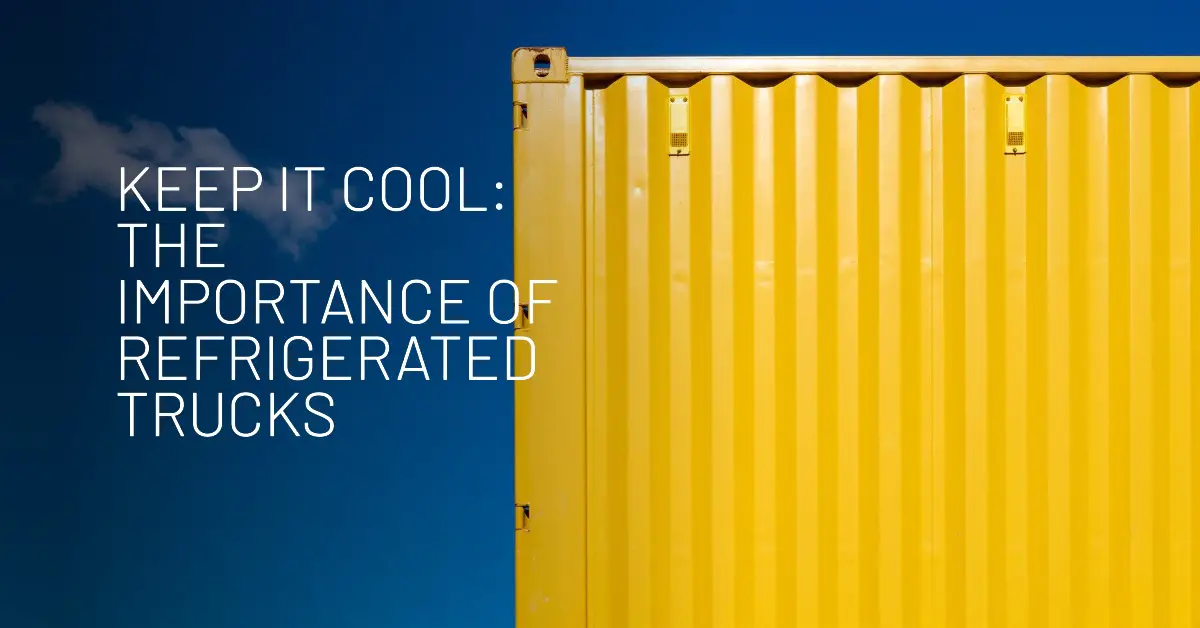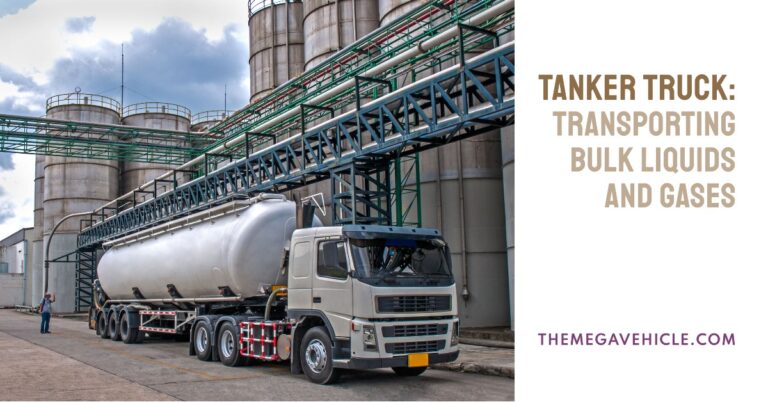Reefer Trucks: What Are They and How Do They Work?

In the world of logistics and transportation, refrigerated trucks, also known as reefer trucks or reefers, stand as stalwart guardians of freshness and quality. These specialized vehicles play a pivotal role in safeguarding perishable goods, ensuring that they reach their destinations in optimal condition. From the vibrant produce gracing our supermarket shelves to the life-saving medicines delivered to hospitals, reefer trucks silently orchestrate a symphony of temperature-controlled transportation, underpinning our modern way of life.
Anatomy of a Reefer Truck
At the heart of a reefer truck lies a carefully engineered system designed to maintain a controlled environment. The truck’s body is meticulously insulated, typically employing polyurethane foam or similar materials, to effectively prevent heat transfer and maintain the desired temperature within the cargo space.
This insulated haven is brought to life by the refrigeration unit, the unsung hero of the reefer truck. This sophisticated piece of machinery utilizes a compressor, evaporator, and condenser system, employing refrigerants like ammonia, R-134a, or R-452A to absorb heat and release it into the surrounding environment.
Types of Reefer Trucks: Catering to Every Need
Reefer trucks come in various sizes and configurations to accommodate a wide range of cargo volumes and transportation requirements. Some common types include:
- Straight Trucks: These are the workhorses of the reefer fleet, featuring a single cargo area and typically used for short-haul or medium-distance deliveries. Their maneuverability and efficiency make them ideal for urban and regional distribution.
- Tractor-Trailer Units: For longer-haul or larger-volume shipments, tractor-trailer units, also known as reefer trailers, take to the highways. These behemoths feature spacious cargo compartments and powerful refrigeration units, capable of transporting vast quantities of perishables over extended distances.
- Multi-Temperature Reefers: When different types of cargo require distinct temperature zones, multi-temperature reefers step up to the challenge. These versatile vehicles feature multiple compartments, each with its own independent temperature control system, allowing for the simultaneous transport of items like frozen vegetables and fresh dairy products.
Components of a Reefer Truck
A reefer truck is a marvel of engineering, meticulously designed to maintain a controlled environment, ensuring the preservation of temperature-sensitive goods. To achieve this feat, several key components work in harmony:
- Insulated Body: The very foundation of a reefer truck lies in its insulated body. Constructed with high-grade insulation materials, typically polyurethane foam or similar compounds, the body acts as a barrier against heat transfer, effectively maintaining the desired temperature within the cargo area.
- Refrigeration Unit: The heart of the reefer truck, the refrigeration unit, actively controls the temperature inside the cargo space. This sophisticated system comprises a compressor, condenser, evaporator, and other components that work together to remove heat from the cargo space and maintain a consistent temperature.
- Temperature Control System: Precision is paramount in the world of perishable goods. Reefer trucks are equipped with advanced temperature control systems that allow operators to set and monitor the desired temperature with pinpoint accuracy. These systems ensure precise temperature control by adjusting the cooling capacity and airflow as required.
- Airflow Management: Proper airflow is essential for effective temperature distribution throughout the cargo area. Reefer trucks feature strategically placed air vents and fans that work in tandem to ensure consistent cooling across all areas of the truck, preventing temperature variations that could compromise the quality of the goods.
- Data Logging and Monitoring: In the age of data-driven decision-making, reefer trucks often incorporate built-in data logging and monitoring systems to maintain product integrity and comply with regulations. These systems meticulously track and record temperature data throughout the transit process, providing valuable information for quality control and auditing purposes.
- Power Source: To power the refrigeration unit and ensure uninterrupted operation, reefer trucks typically have their own independent power source. When parked at a facility, this can be an onboard generator or an external electric connection.
- Safety Features: Safety is paramount in transporting perishable goods. Reefer trucks are equipped with a suite of safety features to protect both the cargo and the operator. Alarms for temperature deviations, door sensors to detect unauthorized access or door openings, and backup power systems to ensure continuous operation in case of power failures are just a few examples.
- Load Securing Mechanisms: To prevent cargo shifting during transit, reefer trucks may have load-securing mechanisms such as adjustable cargo restraint systems, tie-down points, and non-slip flooring materials. These measures maintain stability and protect the integrity of the goods, ensuring that they arrive at their destination in pristine condition.
These components work together in a harmonious symphony, creating a reliable and efficient reefer truck that can safely transport temperature-sensitive products over short or long distances while maintaining the required temperature conditions. Reefer trucks, the unsung heroes of our modern supply chains, play a pivotal role in ensuring that we have access to fresh, high-quality products that enrich our lives.
How does the Refrigeration Unit work in Reefer Truck?
The refrigeration unit in a reefer truck operates on the principle of a vapor-compression refrigeration cycle, a carefully choreographed sequence of transformations that effectively removes heat from the cargo space and maintains a consistent temperature. This cycle consists of four fundamental steps:
1. Compression: The refrigeration unit’s journey begins with the compressor, a powerful pump that draws in refrigerant gas at low pressure and compresses it to a high pressure and temperature. This compression process increases the energy content of the refrigerant, priming it for its cooling mission.
2. Condensation: The hot, high-pressure refrigerant gas then embarks on a journey through the condenser, a network of coils strategically positioned outside the truck. As the gas flows through these coils, it loses heat to the surrounding air, causing it to condense into a high-pressure liquid. This phase transition from gas to liquid releases a significant amount of heat, effectively transferring it away from the cargo area.
3. Expansion: The liquefied refrigerant’s next stop is the expansion valve, a device that acts as a pressure regulator. As the refrigerant passes through this valve, it experiences a sudden drop in pressure, causing it to rapidly expand and vaporize. This transformation, known as flashing, absorbs heat from the surrounding environment, further reducing the temperature within the cargo area.
4. Evaporation: The low-pressure refrigerant vapor, now laden with absorbed heat, enters the evaporator, a heat exchanger located within the cargo space. As the refrigerant circulates through the evaporator’s coils, it continues to absorb heat from the cargo and surrounding air, further cooling the cargo area. This process of evaporation marks the completion of one cycle, and the refrigerant returns to the compressor to repeat the cooling process.
Maintaining Precision: Temperature Control Mechanisms
The refrigeration unit’s cooling capacity is carefully matched to the size and insulation of the reefer truck, ensuring that it can effectively maintain the desired temperature range. To ensure precise temperature control, reefer trucks are equipped with advanced temperature control mechanisms that monitor and regulate the operation of the compressor. These mechanisms, which can be manual or automatic, allow operators to set and maintain specific temperature requirements based on the cargo’s needs.
Additional Components for Enhanced Performance
Several additional components work in harmony with the refrigeration unit to optimize its performance and ensure the integrity of the cargo. These include:
- Defrost system: To prevent ice buildup on the evaporator coils, which can hinder cooling efficiency, reefer trucks often incorporate defrost systems. These systems periodically activate to melt away any accumulated ice, maintaining optimal heat transfer.
- Fans and air vents: For consistent temperature distribution throughout the cargo area, reefer trucks feature strategically placed fans and air vents. These components circulate the cool air, ensuring that even remote corners of the cargo space receive adequate cooling.
How long does it take a reefer to cool down?
The time it takes for a reefer to cool down depends on several factors, including the size of the reefer, the starting temperature of the cargo area, and the desired temperature. In general, it takes between 2 and 4 hours for a reefer to cool down to the desired temperature.
Factors that affect cooling time:
- Size of the reefer: Larger reefers take longer to cool down than smaller reefers.
- Starting temperature of the cargo area: If the cargo area is already cold, the reefer will cool down more quickly.
- Desired temperature: The lower the desired temperature, the longer it will take the reefer to cool down.
Tips for speeding up the cooling process:
- Close all the doors and vents: This will help to trap the cold air inside the reefer.
- Turn the fan on high: This will help to circulate the cold air throughout the cargo area.
- If possible, pre-cool the cargo before loading it into the reefer: This will help to reduce the amount of time it takes for the reefer to cool down.
Additional considerations:
- The type of insulation: Reefers with better insulation will cool down more quickly.
- The efficiency of the refrigeration unit: Newer and more efficient refrigeration units will cool down reefers more quickly.
- The ambient temperature: If the ambient temperature is hot, it will take the reefer longer to cool down.
Here is an example of how long it might take for a reefer to cool down under different conditions:
- A small reefer with a starting temperature of 70 degrees Fahrenheit and a desired temperature of 35 degrees Fahrenheit: 2-3 hours
- A large reefer with a starting temperature of 90 degrees Fahrenheit and a desired temperature of 35 degrees Fahrenheit: 3-4 hours
- A well-insulated reefer with a new refrigeration unit and a starting temperature of 60 degrees Fahrenheit and a desired temperature of 35 degrees Fahrenheit: 1-2 hours
- A poorly insulated reefer with an old refrigeration unit and a starting temperature of 90 degrees Fahrenheit and a desired temperature of 35 degrees Fahrenheit: 4-5 hours
It is important to note that these are just estimates, and the actual cooling time may vary depending on the specific conditions.
The Indispensable Role of Reefer Trucks in Cold Chain Logistics
The cold chain logistics industry, a meticulously orchestrated network that ensures the safe and efficient transportation of temperature-sensitive goods, relies heavily on reefer trucks. These specialized vehicles act as mobile cold storage units, equipped with sophisticated refrigeration systems that maintain a consistent and controlled environment within the cargo area. By preventing spoilage and preserving product integrity, reefer trucks contribute significantly to:
- Food Safety: Reefer trucks prevent the growth of harmful bacteria and microorganisms, thereby safeguarding food safety and minimizing the risk of foodborne illnesses.
- Extended Shelf Life: By maintaining the proper temperature, reefer trucks prolong the shelf life of perishable goods, reducing waste and maximizing their value for consumers and businesses alike.
- Regulatory Compliance: Reefer trucks adhere to strict temperature control regulations, ensuring that products are transported in a compliant manner and meet the highest standards of safety and quality.
Real-Time Monitoring and Tracking
Technological advancements have further enhanced the role of reefer trucks in cold chain logistics. Many modern reefer trucks are equipped with real-time monitoring and tracking capabilities, providing logistics companies with complete visibility and control over their shipments. These advanced systems allow operators to:
- Track the location of their trucks
- Monitor temperature conditions throughout the journey
- Receive alerts for any temperature fluctuations or delays
This real-time information enables logistics companies to take proactive measures to minimize the risk of product damage or spoilage, ensuring that goods arrive at their destinations in optimal condition.
Diverse Applications Of Refrigerated Trucks In Various Industries
The versatility of reefer trucks extends beyond the food industry, making them indispensable in various sectors. Here are some notable applications of reefer trucks across different industries:
- Pharmaceutical Industry: Reefer trucks transport temperature-sensitive pharmaceuticals, vaccines, and medical supplies, ensuring their efficacy and preventing degradation during transit.
- Floral Industry: Reefer trucks maintain the freshness of flowers, plants, and horticultural products, extending their lifespan and ensuring vibrant blooms reach their destinations in pristine condition.
- Catering Services: Reefer trucks keep prepared meals at optimal temperatures for serving, preserving their quality and freshness until they are ready to be enjoyed at events, weddings, or corporate functions.
- Frozen Goods: Reefer trucks maintain extremely low temperatures throughout the journey, ensuring that frozen products, such as ice cream, frozen desserts, frozen fruits, and vegetables, remain frozen until they reach their designated locations.
- Beverage Industry: Reefer trucks transport beverages like juices, soft drinks, beer, wine, and spirits, maintaining their taste and quality during transportation.
History of Reefers
The concept of refrigeration dates back to ancient times when people used natural ice and cold storage techniques to preserve food. However, it wasn’t until the late 19th century that the first mechanical refrigeration systems were developed.
In 1869, French engineer Charles Tellier invented the first practical refrigeration machine. This invention laid the foundation for the future development of reefers. However, it took a few more decades before refrigeration technology was applied to shipping containers.
In the early 20th century, companies like American Fruit Company (now Dole) and United Fruit Company (now Chiquita) recognized the need for a reliable method to transport perishable goods over long distances. They began experimenting with insulated containers and ice bunkers on ships.
The breakthrough came in 1937 when engineer Frederick McKinley Jones patented a portable air-cooling system. Jones’ invention allowed for temperature-controlled transportation of goods, making him a pioneer in the field.
It wasn’t until the 1960s that containerized shipping indeed took off. Malcolm McLean, often credited as the father of containerization, introduced standardized shipping containers that could be easily loaded onto ships, trucks, and trains. With this development, reefers became integral to the global supply chain.
Advancements in technology over the years have made reefers more efficient and reliable than ever before. Today’s reefers use advanced insulation materials, sophisticated temperature control systems, and GPS tracking to deliver perishable goods across long distances safely.
Reefers have enabled global trade in perishable products such as fruits, vegetables, pharmaceuticals, and other temperature-sensitive items. They have revolutionized how we transport and store these goods, extending their shelf life and reducing waste.
The Bottom Line
Reefer trucks have become an indispensable component of modern supply chains, playing a critical role in ensuring the safe, efficient, and compliant transportation of temperature-sensitive goods. Their ability to maintain precise temperature conditions, coupled with advanced monitoring and tracking capabilities, has made them invaluable assets in various industries. As the demand for perishable goods continues to grow, the importance of reefer trucks will only increase in the years to come, further solidifying their position as silent sentinels of freshness and quality.







One Comment